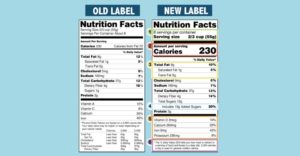
Understanding the New Food Label
The food label was introduced with the goal of helping consumers make healthier food choices. However, the U.S. Food and Drug Administration has finalized a new food label for packaged foods that will make it even easier for you to make informed choices that support a healthy diet. Some of the changes that have been made to the label include updated serving sizes and daily values, larger and bolder font on the calories and serving size, the addition of added sugars, new nutrient requirements and a different foot note.
- The “Servings per Container” and “Serving Size” declarations have increased and are now larger and bolder on the food label. These serving sizes have been recreated to reflect what people actually eat and drink today. For example, the serving size for ice cream was 1/2 cup and is now 2/3 cup. There are also new requirements for certain sized packages. These include those that are between one and two servings or are bigger than a single serving but could be consumed in one or multiple sittings.
- “Calories” are now presented much larger and bolder than ever before, which can help consumers be aware of the calorie content before they consume the product. By highlighting the calorie count, the FDA is attempting to call attention to the link between obesity and heart disease, certain cancers, diabetes and stroke.
- “Calories from Fat” has been taken off the food label because research has shown that the type of fat consumed is more important than the actual amount. Over the years, fat has been given a bad reputation, but healthy fat is essential in your diet. Fat is needed to insulate our bodies, give us energy, protect our organs, absorb certain nutrients and produce important hormones. However, you should limit the amount of saturated fat you consume and avoid trans fat completely. Saturated and trans fats can cause a buildup of plaque in the arteries, resulting in diseases such as atherosclerosis or heart disease. Aim to consume more monounsaturated and polyunsaturated fats, which can reduce the risk for developing these diseases.
- “Added Sugars” in grams and as a percent Daily Value (%DV) is now required on the food label. This addition will help consumers to understand the difference between natural and added sugar. Added sugars include sugars that are either added during the processing of foods or are packaged such as a bag of table sugar, sugars from syrups, honey, and sugars from concentrated fruit or vegetable juices. Try to limit your intake of added sugars to no more than 10% of your total daily calories.
- Before the change, food labels featured vitamins and minerals such as iron, calcium, vitamin A and vitamin C. While manufacturers can still voluntarily include vitamins A and C, the FDA finds that few Americans are deficient in these vitamins. Many products are fortified with vitamin A and C, which helps to prevent deficiency. Today, many Americans do not get the recommended daily amounts of Vitamin D and potassium. The new food label features iron, calcium, potassium and vitamin D. Adding these nutrients to the new food labels can help prevent the risk of injury and health related diseases. All of these vitamins and minerals are essential and have many important roles in the body. Vitamin D is needed to effectively absorb calcium, which is needed for strong bones and teeth. Consuming the recommended amount of potassium is just as important as reducing your sodium intake. Potassium blunts the effect of a high sodium diet and is needed for the rhythmic beating of your heart, muscle contraction, and blood pressure regulation. Lastly, iron is needed to help your red blood cells carry oxygen from your lungs to transport it throughout the body.
- The footnote at the bottom of the food label has changed to better explain the meaning of the Percent Daily Value (% DV). The % DV is a guide to the nutrients in one serving of food. Daily Values are based off of a 2,000-calorie diet for healthy adults. This percentage will tell you whether a food is low or high in a specific nutrient. If a food has less than 5% of a nutrient, it is considered to be low in that nutrient. If a food is 20% or higher in a nutrient, it is high in that nutrient.
References:
https://recipes.howstuffworks.com/fda-unveils-new-food-nutrition-labels.htm
https://foodandhealth.com/food-label-vitamins-minerals/

